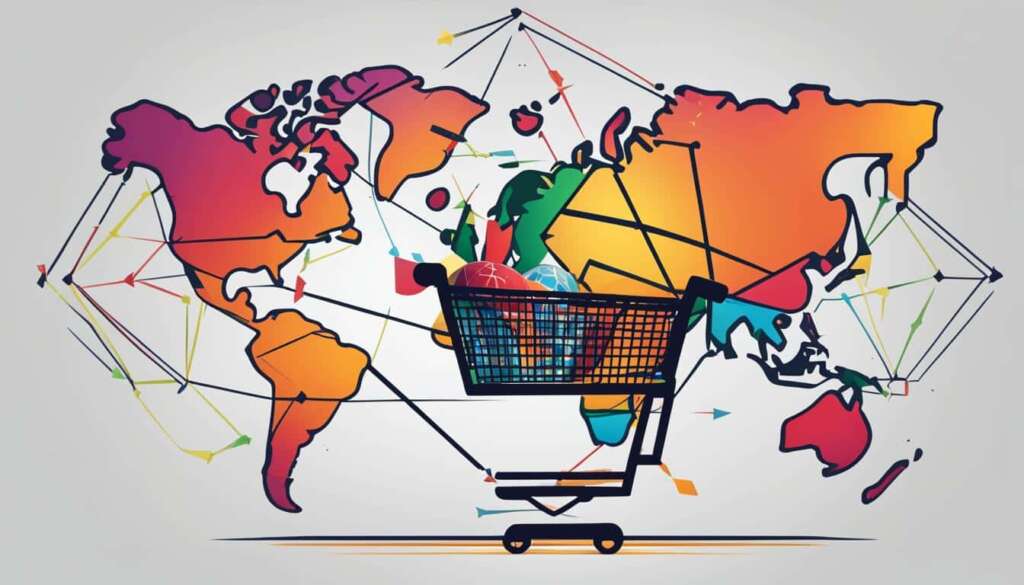Table of Contents
Welcome to our comprehensive guide on cross-border e-commerce, where we explore the latest trends and strategies that will shape the industry in 2023. As the global marketplace continues to expand, businesses are increasingly looking to tap into the lucrative opportunities offered by cross-border trade. With the rapid growth of international trade, it is crucial for businesses to stay ahead of the curve and implement effective strategies to navigate this dynamic landscape.
In this article, we will delve into the key trends driving cross-border e-commerce and discuss the strategies that businesses can adopt to thrive in this competitive arena. From the rising demand for global products to the challenges and opportunities of trading across borders, we will provide valuable insights and actionable tips to help you succeed in the cross-border e-commerce market.
To kickstart our journey, let’s take a closer look at the current market trends and the exciting possibilities that lie ahead for businesses engaged in cross-border e-commerce. By understanding the trends shaping the industry, businesses can tailor their strategies to maximize their potential and stay ahead of the competition.
With the global market projected to witness substantial growth, it is essential for businesses to stay informed and adapt to the evolving cross-border e-commerce landscape. In the following sections, we will explore the ins and outs of cross-border e-commerce, ranging from its definition and benefits to the various challenges and opportunities it presents. We will also discuss the successful product categories and delve into the necessary considerations for ensuring safe and secure cross-border trading.
Whether you’re an established business looking to expand your reach or an aspiring entrepreneur eyeing the global market, this guide will equip you with the knowledge and strategies needed to harness the full potential of cross-border e-commerce. Join us on this transformative journey as we unravel the secrets to success in the world of cross-border trade.
What is Cross-Border E-commerce?
Cross-border e-commerce is a rapidly growing phenomenon that involves the buying and selling of goods and services online between individuals or businesses located in different countries. This form of e-commerce enables businesses to expand their reach and access a wider customer base in international markets, transcending the constraints of traditional brick-and-mortar establishments.
With cross-border e-commerce, businesses can connect with customers from around the world, offering them a diverse range of products and services. This, in turn, provides customers with access to a broader selection of goods and the ability to compare prices across different borders. As a result, cross-border e-commerce has opened up new opportunities for businesses to thrive and consumers to benefit from competitive prices and unique products.
“Cross-border e-commerce enables businesses to transcend geographical boundaries and tap into lucrative international markets, offering immense growth potential.”
The growth of cross-border e-commerce can be attributed to several factors, one being the increasing connectivity of the global economy. The widespread use of the internet has made it easier for businesses to establish an online presence and connect with customers worldwide, regardless of their location. This has eliminated the need for businesses to have a physical presence in every country they wish to operate in.
Furthermore, the global reach of cross-border e-commerce has been facilitated by advancements in logistics and shipping, enabling swift and efficient international delivery of products. Additionally, the availability of secure online payment systems has bolstered customer trust and confidence in cross-border transactions.
By breaking down international borders, cross-border e-commerce presents businesses with endless opportunities for growth and expansion. It allows them to explore untapped markets and target specific customer segments with tailored offerings.
However, engaging in cross-border e-commerce presents its own unique challenges. These challenges can include navigating legal and compliance requirements in multiple jurisdictions, addressing currency conversion issues, managing international shipping logistics, overcoming language barriers, and adapting to cultural nuances. Businesses must be proactive in addressing these challenges to thrive in the cross-border e-commerce landscape.
Why is Cross-Border E-commerce a Trend?
Cross-border e-commerce has become a popular trend due to several factors. The internet has revolutionized the way businesses operate, enabling them to reach customers globally through e-commerce platforms and social media, transcending geographical boundaries. This has opened up new possibilities for business growth and expansion.
As the world becomes increasingly connected, customers have become more familiar with buying products from other countries. They are now more receptive to cross-border transactions and have gained confidence in the reliability and efficiency of international online purchases. This increased trust in cross-border e-commerce has fuelled its growth and paved the way for businesses to tap into new markets and leverage the opportunities presented by the global economy.
A key driving force behind the popularity of cross-border e-commerce is the immense potential for business growth and profitability. By expanding their reach beyond their domestic markets, businesses can significantly increase their customer base and revenue. Additionally, venturing into new markets allows businesses to diversify their offerings and offer unique products or services that cater to the diverse needs and preferences of international customers. This strategic move grants businesses a competitive edge by positioning them as global players in the ever-evolving digital marketplace.
Moreover, cross-border e-commerce plays a vital role in promoting global commerce and breaking down barriers between countries. It facilitates international trade by creating a seamless platform for businesses and consumers to transact, regardless of their physical location. This fosters economic growth on a global scale and encourages collaboration and cultural exchange between nations. Through cross-border e-commerce, businesses can contribute to the development of a thriving and interconnected global economy.
“Cross-border e-commerce has revolutionized business operations, allowing companies to reach a global customer base and drive unprecedented growth. The internet has bridged the gap between countries, enabling seamless cross-border transactions and fostering economic integration.”
Benefits of Cross-Border E-commerce
- Access to a global customer base
- Opportunity for business expansion and growth
- Diversification of product offerings
- Increased revenue and profitability
- Promotion of global commerce and economic integration
By embracing cross-border e-commerce, businesses can tap into the vast potential of the global marketplace, harness the power of the internet, and drive unprecedented business growth in the digital age.

Who Can Benefit from Cross-Border E-commerce?
Cross-border e-commerce offers numerous advantages for various groups, allowing them to thrive in the global marketplace. Here are some key beneficiaries:
1. Small and Medium-Sized Businesses (SMBs)
SMBs can now access customers in other countries without the need for physical stores or infrastructure. This opens up immense opportunities for growth and expansion.
2. Niche Markets
Businesses in niche markets can leverage cross-border e-commerce to reach new customers who have specific demands. This allows them to tap into untapped markets and increase revenue.
3. Developed Countries
Businesses operating in developed countries can harness cross-border e-commerce to meet the demand for their products and services in developing countries. This expands their customer base and generates additional revenue streams.
4. Customers in Developing Countries
Customers in developing countries can access a wider range of products through cross-border e-commerce. This offers them greater choice and the opportunity to purchase items that may not be available locally.
5. Entrepreneurs and Creators
Entrepreneurs and creators can use cross-border e-commerce to showcase their products or services on a global stage. This enables them to reach a broader audience and unlock international growth potential.
6. Dropshippers and E-tailers
Dropshippers and e-tailers can benefit from cross-border e-commerce by selling products to customers internationally without the need to deal with complex international shipping logistics. This makes it easier for them to expand their business operations.
“Cross-border e-commerce offers immense opportunities for small and medium-sized businesses, niche markets, developed countries, customers in developing countries, entrepreneurs, dropshippers, and e-tailers to reach global audiences, tap into new markets, and drive growth.”
By embracing cross-border e-commerce, these various groups can harness the power of international trade and connect with customers from around the world. It enables business growth, expands market reach, and stimulates economic development.
Challenges of Cross-Border E-commerce
Undoubtedly, cross-border e-commerce presents unique challenges that businesses must navigate to succeed in the global market. From legal and compliance issues to currency conversion, logistics and shipping, localization, payment methods, language barriers, cybersecurity, and returns and refunds – each aspect demands careful consideration and strategic planning.
“Cross-border e-commerce: A complex yet rewarding landscape for businesses willing to embrace the global market.”
Legal and compliance: Every country has its own set of laws and regulations governing e-commerce transactions. Businesses need to comply with these regulations to avoid legal consequences and ensure a smooth cross-border trading experience.
Currency conversion: Dealing with different currencies can be challenging for businesses engaged in cross-border e-commerce. Fluctuating exchange rates and associated fees can impact pricing and profitability. Therefore, businesses need to consider efficient and cost-effective currency conversion strategies to facilitate seamless transactions.
Logistics and shipping: Shipping products internationally involves complex logistics, including customs clearance, international shipping fees, and delivery times. Businesses must partner with reliable logistics providers to ensure timely and secure delivery of goods to customers worldwide.
Localization: Adapting to the cultural nuances and preferences of different markets is essential for businesses operating in cross-border e-commerce. Localizing products, content, and marketing strategies can enhance customer engagement and foster trust.
Payment methods: Different countries have varying payment preferences and systems. Businesses need to offer a range of payment methods to accommodate customers’ preferences, such as credit cards, digital wallets, or local payment platforms.
Language barriers: Language differences can hinder effective communication and customer support. Investing in translation services or multilingual customer support can help mitigate language barriers and improve customer satisfaction.
Cybersecurity: With the growth of cross-border e-commerce, cybersecurity threats have become more prevalent. Businesses must prioritize cybersecurity measures to protect customer data, secure online transactions, and safeguard against potential cyber attacks.
Returns and refunds: Handling returns and refunds in various countries can be challenging. Businesses need to establish clear and transparent policies, address customer queries promptly, and ensure smooth returns and refund processes.
| Challenges | Strategies |
|---|---|
| Legal and compliance | Ensure compliance with local laws and regulations, consult legal experts |
| Currency conversion | Use efficient currency conversion services, consider currency fluctuations |
| Logistics and shipping | Partner with reliable logistics providers, optimize shipping processes |
| Localization | Adapt products and marketing strategies to align with local culture and preferences |
| Payment methods | Offer a variety of payment options to cater to customer preferences |
| Language barriers | Invest in translation services or multilingual customer support |
| Cybersecurity | Implement robust cybersecurity measures, protect customer data |
| Returns and refunds | Establish clear policies, provide responsive customer support |
Note: These strategies are not exhaustive but provide a starting point for businesses to overcome the challenges of cross-border e-commerce.
While these challenges may seem daunting, with proper planning and expert guidance, businesses can overcome them and thrive in the global market. Engaging with experienced cross-border e-commerce partners, leveraging technology solutions, and staying informed about international trends and best practices can significantly contribute to success.
Successful Product Categories in Cross-Border E-commerce
When it comes to cross-border e-commerce, certain product categories have proven to be highly successful. These categories cater to the global demand for various goods and provide customers with the opportunity to access a wide range of options from international sellers. Let’s explore some of the most popular product categories in cross-border e-commerce:
Fashion and Clothing
With fashion being a universal language, it’s no surprise that clothing is a top-selling category in cross-border e-commerce. Customers are drawn to the latest fashion trends and unique styles offered by international brands. From designer apparel to affordable fashion options, cross-border e-commerce provides a gateway for customers to access a diverse range of clothing choices.
Electronics
Electronics are another popular product category in cross-border e-commerce. Customers are often seeking the latest gadgets and cutting-edge technology at competitive prices. International sellers can offer a wide selection of electronics, including smartphones, laptops, cameras, and home entertainment systems, satisfying the global demand for these products.
Beauty and Personal Care
In the beauty and personal care category, customers across borders are keen on exploring international brands and discovering new products. Cross-border e-commerce allows customers to access a variety of cosmetics, skincare, haircare, and personal care products that may not be available in their local markets. From Korean beauty brands to European luxury skincare, the beauty and personal care category thrives in the cross-border e-commerce landscape.
Home and Garden
Home and garden products have gained popularity in cross-border e-commerce due to their universal appeal. Customers globally have a penchant for home decor, furniture, kitchen appliances, gardening tools, and more. With cross-border e-commerce, customers can explore unique and stylish home and garden products from international sellers, enhancing their living spaces with a touch of global flair.
Sports and Outdoors
The sports and outdoors category also experiences substantial success in cross-border e-commerce. Customers worldwide seek high-quality sporting equipment, activewear, outdoor gear, and adventure accessories. Cross-border e-commerce allows customers to access a wide range of sports and outdoor products, catering to their unique interests and active lifestyles.
Books, Music, and Media
Books, music, and media products have transitioned seamlessly into the digital realm of cross-border e-commerce. Customers can now explore a vast library of international books, music albums, movies, and e-books. With the convenience of digital downloads and international shipping options for physical products, customers indulge in a global collection of literary and entertainment experiences.
Food and Beverages
Food and beverages offer a unique category in cross-border e-commerce, enabling customers to explore culinary delights from around the world. From gourmet chocolates to exotic spices, customers can access a global pantry through cross-border e-commerce. Additionally, customers can indulge in international wines, spirits, and specialty beverages, expanding their palate with flavors from different cultures.
| Product Category | Key Features | Customer Benefits |
|---|---|---|
| Fashion and Clothing | Latest trends, unique styles | Access to diverse clothing options |
| Electronics | Cutting-edge technology, competitive prices | Wide selection of gadgets and electronics |
| Beauty and Personal Care | International brands, new product discoveries | Access to a variety of cosmetics and personal care products |
| Home and Garden | Unique home decor, stylish furniture | Enhancing living spaces with global flair |
| Sports and Outdoors | High-quality equipment, outdoor gear | Catering to active lifestyles with a wide variety of products |
| Books, Music, and Media | Global library, digital and physical options | Access to a wide range of international literature and entertainment |
| Food and Beverages | Exotic flavors, gourmet options | Exploring culinary delights from around the world |
These successful product categories showcase the vast opportunities available in cross-border e-commerce. From fashion and electronics to beauty and home goods, customers have access to a global marketplace offering diverse products at competitive prices. By leveraging the power of cross-border e-commerce, businesses can tap into the global demand and attract customers from various corners of the world.
Ensuring Safety in Cross-Border Trading
In the world of cross-border e-commerce, ensuring safety in trading is paramount for businesses. There are several key factors to consider when it comes to protecting both the company and its customers. By understanding the legal and compliance requirements, choosing reputable payment processors, relying on reliable logistics and shipping companies, appreciating cultural nuances, prioritizing cybersecurity, and having a robust system in place for handling returns and refunds, businesses can trade across borders with confidence.
“To protect themselves and their customers, businesses must understand the laws and regulations of the countries they trade with,” advises Emma Stevens, an expert in international trade law at Stevens & Co. “Each country has its unique legal and compliance requirements that must be met to avoid any potential pitfalls.”
Using a reputable payment processor is essential for cross-border e-commerce transactions. Trusted platforms such as PayPal and Stripe offer secure payment solutions that protect sensitive customer information and ensure smooth financial transactions. By partnering with a reliable payment processor, businesses can build trust with customers and reduce the risk of fraud.
“Operating cross-border requires careful consideration of logistics and shipping,” says Mark Thompson, CEO of Global Logistics Solutions. “Choosing a reliable logistics provider can make all the difference in delivering goods safely and on time. This minimizes the risk of delayed or lost shipments.”
When conducting international business, it’s crucial to consider cultural nuances. Different countries have various customs, traditions, and business practices that can influence the success of cross-border transactions. By understanding and respecting these cultural differences, businesses can establish positive relationships with customers and create lasting impressions.
Cybersecurity is a significant concern in cross-border e-commerce. With the increase in cyber threats and data breaches, businesses must prioritize online security. Implementing robust cybersecurity measures, such as secure payment gateways, encryption, and regular security audits, helps safeguard customer data and prevents unauthorized access.
“In cross-border transactions, returns and refunds can be more complex,” explains Laura Wilson, a customer service specialist at Cross-Border Solutions. “Having clear and transparent processes in place for handling returns and refunds ensures customer satisfaction and builds trust in the business.”
By taking these precautions, businesses can protect themselves and their customers throughout the cross-border trading process. Maintaining legal compliance, leveraging reputable payment processors, partnering with reliable logistics and shipping providers, respecting cultural nuances, prioritizing cybersecurity, and implementing efficient returns and refunds processes all contribute to a safer and more successful cross-border trading experience.
Key Tips for Ensuring Safety in Cross-Border Trading:
- Research and comply with the laws and regulations of each country.
- Choose reputable payment processors, such as PayPal or Stripe, for secure transactions.
- Work with reliable logistics and shipping companies to ensure smooth delivery.
- Understand and respect cultural nuances to build positive relationships with customers.
- Implement robust cybersecurity measures to protect customer data.
- Establish clear and transparent processes for handling returns and refunds.
| Legal and Compliance | Payment Processor | Logistics and Shipping |
|---|---|---|
| Understand and comply with the laws and regulations of each country. | Choose reputable payment processors for secure transactions. | Work with reliable logistics and shipping providers for timely and safe delivery. |
| Cultural Nuances | Cybersecurity | Returns and Refunds |
|---|---|---|
| Respect cultural differences to establish positive relationships with customers. | Implement robust cybersecurity measures to protect customer data. | Have clear and transparent processes in place for handling returns and refunds. |

Conclusion
Cross-border e-commerce is a burgeoning trend that offers immense potential for business growth in the global market. By implementing effective strategies and carefully considering key factors such as legal compliance, currency conversion, logistics, localization, payment methods, language barriers, cybersecurity, and customer satisfaction, businesses can thrive in this dynamic landscape.
To maximize success in cross-border e-commerce, it is crucial for businesses to stay abreast of the latest trends and adapt to the evolving market dynamics. This requires continuous monitoring of consumer preferences, technological advancements, and regulatory changes. By proactively adjusting their strategies, businesses can leverage the opportunities presented by the global market and drive sustainable growth.
As the world becomes increasingly interconnected, cross-border e-commerce serves as a gateway for businesses to reach new customers and explore untapped markets. By harnessing the power of e-commerce platforms and the internet, businesses can transcend geographical boundaries and establish a strong international presence. This not only fosters business expansion but also fosters economic growth on a global scale.
In conclusion, cross-border e-commerce is a dynamic and promising avenue for business growth. By adopting the right strategies and capitalizing on the evolving trends, businesses can position themselves for success in the global marketplace. With a commitment to excellence in customer experience, adherence to legal and compliance requirements, and the utilization of effective marketing strategies, businesses can unlock the vast potential offered by cross-border e-commerce and achieve long-term business growth.
FAQ
What is cross-border e-commerce?
Cross-border e-commerce refers to the buying and selling of goods and services online between individuals or businesses in different countries.
Why is cross-border e-commerce a trend?
Cross-border e-commerce is a trend due to factors such as the internet making it easier for businesses to reach global customers, increasing connectivity between countries, and the desire for businesses to expand their reach and tap into new markets.
Who can benefit from cross-border e-commerce?
Several groups can benefit from cross-border e-commerce, including small and medium-sized businesses, niche market businesses, businesses in developed countries, customers in developing countries, entrepreneurs, dropshippers, and e-tailers.
What are the challenges of cross-border e-commerce?
Challenges include navigating laws and regulations, managing currency conversion, handling international shipping logistics, considering cultural differences, adapting to different payment methods, overcoming language barriers, ensuring cybersecurity, and handling returns and refunds in various countries.
What are successful product categories in cross-border e-commerce?
Successful product categories in cross-border e-commerce include fashion and clothing, electronics, beauty and personal care, home and garden, sports and outdoors, books, music and media, and food and beverages.
How can safety be ensured in cross-border trading?
Safety in cross-border trading can be ensured by understanding the laws and regulations of trading countries, using reputable payment processors and logistics companies, considering cultural nuances, prioritizing cybersecurity, and having processes in place for handling returns and refunds.
What strategies and considerations are important for cross-border e-commerce?
Strategies and considerations for cross-border e-commerce include legal compliance, currency conversion, logistics, localization, payment methods, language barriers, cybersecurity, and customer satisfaction.













